SCP is taking another new step to unblock the massive but challenging gas reserves of the Yanbei field for the resource holder and our collaboration partner, Yanchang Petroleum. Yanbei’s valuable resources are buried 3.5 km under the rolling hills of northern Shaanxi.
SCP正在采取新舉措,助力資源方兼合作夥伴——延長石油,開采延北氣田龐大且極具挑戰的氣藏。延北寶貴的資源,正埋藏在陝北綿延起伏的群山之下3.5km深處。
At these great depths, there exist fossilized 260-million-year-old river systems stacked on top of each other after repeated cycles of glaciation. Over the eons, the pressure from these overlying layers crushed buried vegetation into coal which, in turn, released natural gas which collected in the porous sandstones of these ancient riverbeds. Now it is our duty to drill down to produce this resource to the surface to benefit China’s energy supply.
這裏,埋藏著兩億六千萬年的石化河流體係,曆經循環反複的冰川作用後,它們堆積交織在一起。億萬年來,這些重疊壓覆的層位壓力碾碎掩埋的植被,變成煤碳,進而釋放出天然氣,隨後,天然氣便在這些遠古河床的砂岩孔隙中聚集。現在,我們肩負的使命是,鑽井采氣,把這些天然氣資源開采出來,助力中國的能源供應。
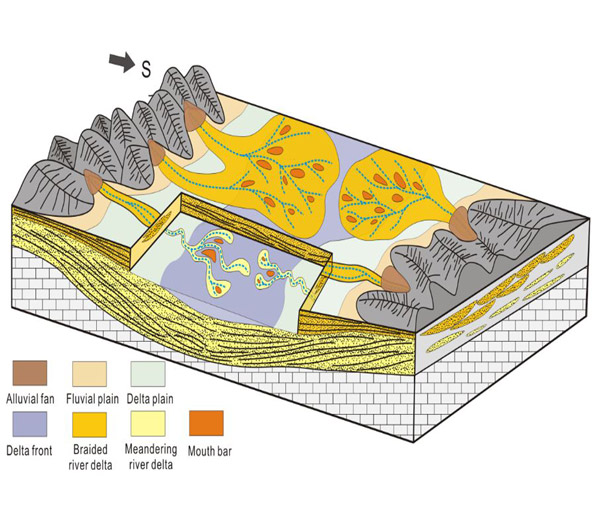
圖:A general model of the original depositional environment
原始沉積環境的一般模式
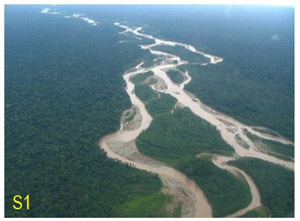
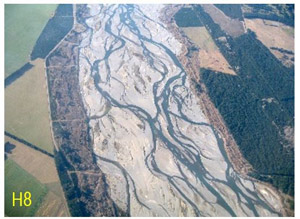
圖:Examples of what the original rivers that made S1-H8 looked like
形成S1-H8的原始河流例子
But it takes technology investment and skill to locate these rock formations. And it is not enough just to drill a well into this rock, as it is so impermeable that no gas can flow through it unless we also create a network of small fractures spreading out from each well into the reservoir. These fractures open the rock pores and free the trapped gas so it can flow to the surface.
不過,找到這些岩層需要技術投資和技巧。而且,僅僅在一塊岩石上鑽一口井是不夠的,因為岩石滲透率低,天然氣無法滲透,除非我們在每口井與氣藏之間創建一張由細小裂縫構成的網絡,由這些裂縫打開岩石孔隙,釋放出受困的天然氣,流向地麵。
This approach has been proven effective to develop a group of rock layers called S2-3, which contain nearly half of Yanbei’s gas. To fracture S2-3 layers and release the gas, we pump into each well, a slurry consisting of gum-thickened water and tiny ceramic grains at high pressure. Our engineers use advanced engineering software to determine the pumping pressure and fluid specifications. After a sufficiently large fracture network has been created, we stop the pumps and allow the natural rock pressure to try to clamp the fractures closed, but the closure process stops when it encounters the solid ceramic grains. Billions of these grains “prop” the crack open (hence they are called “proppant”) and allow the gas from the rock pores to flow past them into the wellbore and thence to the surface.
已證實該方法是有效,能用於開發山2-3層位,山2-3包含了延北近一半的氣藏。為了壓裂山2-3層位釋放天然氣,我們用高壓泵注入粘稠水和陶粒砂混合而成的泥漿。我們的工程師使用先進的工程軟件,來確定泵送壓力和入井液規格。當一張足夠大的裂縫網形成後,我們停止泵送,讓岩石的自然壓力去夾緊閉合裂縫,但當遇到固體陶粒砂時,裂縫閉合的過程會停止。數十億陶粒砂“撐開”裂縫(因此陶粒砂也被稱為“支撐劑”),使岩石孔隙中的天然氣穿過支撐劑,進入井筒,到達地麵。
Apart from S2-3, most of the rest of the Yanbei's gas lies in another group of rock layers called S1-H8 which was prehistorically formed from narrow, slow, meandering rivers, whose now-mineralised riverbeds comprise a mix of fine gas-bearing sand and other non-gas bearing rock.These geological factors make it much harder to extract gas from S1-H8 than from the cleaner, bigger sands of S2-3. In S1-H8, firstly, the non-gas bearing rock is indistinguishable from good sand on the seismic images that we use to locate the reservoir. Secondly, the narrow rivers that formed S1-H8, resulted in thinner, and therefore smaller, gas reservoirs. Thirdly, because the original rivers were sluggish, they allowed finer deposits to settle, leading to a less porous reservoir rock. As if that were not enough, inside S1-H8’s smaller rock pores (compared to S2-3), the individual tiny puffs of gas lack the momentum to overcome relatively massive water droplets glued to the rock by surface tension.
除了山2-3外,延北剩餘大部分氣儲藏在另一組被稱為山1盒8的層位中。山1盒8由史前狹窄、舒緩、蜿蜒的河道形成,現已礦化的河床由含氣的細砂和其他非含氣岩石混合而成。這些地質因素,使得從山1盒8中提取天然氣,比從更清潔、更大塊的山2-3砂體中提取,要困難很多。首先,山1盒8層位中的非含氣砂岩,相較於地震圖像上我們用於定位儲層的優質砂岩,二者難以區分。其次,形成山1盒8的河道很狹窄,導致氣藏更薄,也更小。第三,由於原始河流流速緩慢,允許更精細的礦物沉澱下來,導致儲層岩孔隙更小。不僅如此,與山2-3相比,由於山1盒8的岩石孔隙較小,單個微小的一縷一縷的天然氣缺乏勢氣,難以突破相對大量的因表麵張力附著在岩石上的水滴。
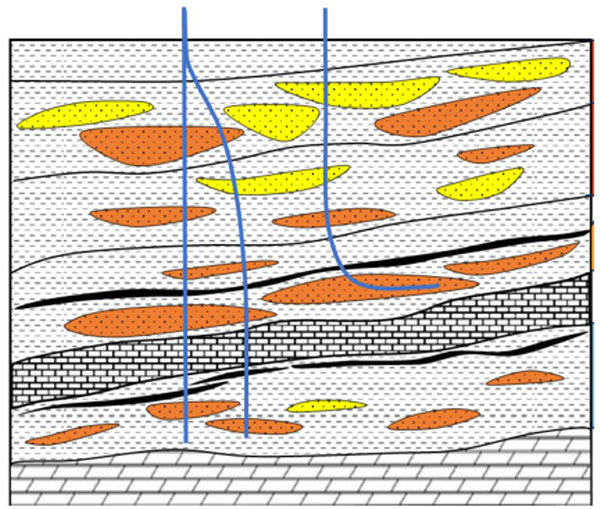

左圖:Drilling patterns to reach the reservoir units
到達油藏單元的鑽井模式
右圖:Micrographs of the different rock qualities
不同岩石質量的顯微照片
In any case, in 2014 at the start of the development drilling we, perhaps optimistically, tried the S2-3 frac design on some S1-H8 wells. With hindsight, the results, not surprisingly, were poor. Our investigation concluded that the high-water content slurry was flooding already-wetted rock pores and obstructing gas outflow.
2014年,鑽井開發伊始,我們或許樂觀地把山2-3的壓裂設計,用在了山1盒8的氣井上。事後看來,壓裂結果不理想,似乎並不意外。調查結論顯示,高含水的泥漿淹沒了本已潮濕的岩石孔隙,阻礙了天然氣流出。
After these initial results, SCP appointed a research taskforce to work on the S1-H8 problem in parallel with the main S2-3 development focus. The taskforce team surveyed the global state of the art for stimulating such reservoirs and concluded that there was no off-the-shelf solution to unlock this gas, and while many companies had tried elsewhere, the one-off success cases could not be directly applied to Yanbei.
得到這些初步結果以後,SCP組建了一支攻關小組,來攻克山1盒8難關,與主力層山2-3的開發齊頭並進。該小組調查了全球現有的此類氣藏的改造技術,得出的結論是,沒有現成的解決方案可用來開采此類氣藏,雖然許多公司已經在其他地方嚐試過,但一次性的成功案例不能直接應用到延北項目上。
Consequently, the taskforce chose a step by step approach the progress into the unknown – choosing as its breakthrough attempt in 2017 a so-called “volume frac” design: It was hoped that by creating much bigger fractures they would propagate far enough to dissipate near-wellbore water blockage effects. Using water was a cost-effective way to increase the size of the fracture. However, the hopes for a breakthrough were dashed as severe water blockage re-occurred, and gas productivity remained low. Nevertheless, this was an important final attempt with water because the next logical step, moving away for water as the main fluid, would entail new challenges and costs.
因此,攻關小組采用了循序漸進的方法來探索未知。2017年,他們選擇了一種稱為“大規模壓裂”的設計來作突破性嚐試:希望壓裂規模越大,裂縫延伸得足夠遠,井筒附近的水鎖效應就會自然消失。用水來壓裂是擴大裂縫的一種經濟有效的方法。然而,攻關的希望破滅了,因為再次發生了嚴重水堵,天然氣產量仍然很低。不過,用水來壓裂的這次嚐試也很重要,因為下一步的合理措施是,不再用水作為主要入井液,這又將帶來新挑戰,產生新成本。
In 2018, the taskforce’s post-trial review confirmed that the only way to achieve adequate gas flow rates was to reduce the slurry’s water content by adding a non-aqueous fluid. CO2 was selected because even though it is normally a gas, when pressurised it liquefies and so can be easily pumped. However, using 100% CO2 at -40C would have placed excessive thermal stresses on the equipment and would have been very expensive and logistically challenging on our small remote well pads. So, we settled for a 60/40 CO2/water mix instead.
2018年,攻關小組的試後評估證實,要獲得足夠的天然氣流速,唯一的辦法是使用CO2這種非水性流體來降低泥漿的含水量。之所以選擇二氧化碳,是因為盡管它通常是氣體,但加壓後會液化,因此很容易泵送。 但使用零下40℃ 的 100% 純 CO2 會給設備帶來過大的熱應力,並且對於我們小型偏遠的井場而言,成本太高,後勤支持也會麵臨挑戰。 因此,我們把二氧化碳/水的比率設定為60/40 。
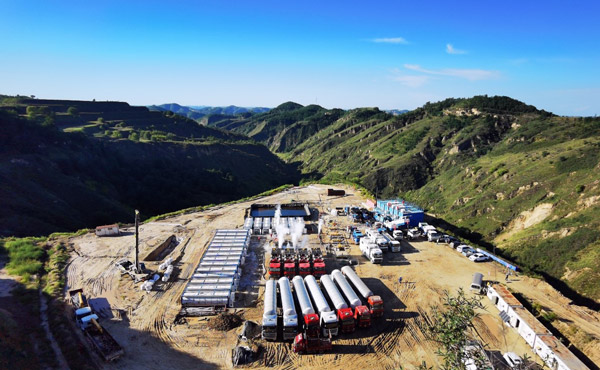
圖:Liquid carbon-dioxide frac operations
液態二氧化碳壓裂作業
Happily, initial gas rates from this trial were many times higher than previous trials. It was a real step in the right direction to defeat our water block demon. However, the higher rates could not be sustained as long as required. So, this presented us with the next challenge - ie how to scale up the technique to achieve both high production rates and high ultimate recovery volumes.
欣喜的是,這次試驗的初始氣量比前幾次試驗高很多倍,標誌著我們在打敗水鎖惡魔的正確方向上邁進了真正一步。 但高產量不能持續所需的時長。 因此,這給我們帶來了下一個挑戰——如何擴大技術規模,來實現高產量和最終的高采收率?
This brings us to the present day. A lot has happened in the interim in SCP. After successfully completing the technologically demanding execution and start up phases of the project, Schlumberger and Copower agreed to swap roles within their close partnership to give the lead to Copower’s entrepreneurial mindset, underpinned by Schlumberger’s world-class technology.
到目前為止, SCP 做了很多優化調整。成功完成延北項目高技術的建設與投產後,斯倫貝謝與長和實業同意,在其緊密的合作夥伴關係中互換角色,由長和實業來主導實施企業戰略,由斯倫貝謝來提供世界一流的技術支持。
Now a reconstituted S1-H8 research taskforce, is harnessing the best of Schlumberger technology and domestic experience to make the next breakthrough. Experience in other basins has shown that multi-organisational collaboration is a must for breakthrough projects like this, and so we are also reaching out to research institutes and other companies.
現在,SCP重新組建了一支山1盒8 攻關小組,該小組正在充分利用斯倫貝謝技術和國內先進經驗,來努力取得下一個突破。其他盆地的經驗表明,多組織合作是此類項目取得突破的必要條件,因此我們正在與其他研究機構和企業接洽。
Currently the team has identified three focus areas: (i) productivity (ii) cost (iii) well targeting. The top S1-H8 priorities in 2021 remain (i) & (ii) - productivity and cost. Productivity is key because unless a well exceeds a critical gas rate, it will always need expensive nursing to avoid choking on its own water production. For the latest batch of trials we are applying lessons from the CO2 trials to minimise water content, and lessons from recent S2-3 well trials to maximise fracture size.
目前,攻關小組確定了三個重點領域:(i) 產量 (ii) 成本 (iii) 井位。 2021 年,山1盒8攻關的重點仍然是 (i) 和 (ii) ——產量和成本。產量是關鍵,因為除非氣井產量超過了臨界產量,否則一直需要采取昂貴的措施,來避免氣井因自身出水而導致水堵。在當前批次的試驗中,我們吸取了 CO2 壓裂試驗的經驗,把含水量降至最低,也吸取了最近山S2-3試驗的經驗,使壓裂規模最大化。
Cost is also critical to ensure the well is commercial and economic. So, to drive costs down we are also switching from CO2 to a cheaper and more environmentally friendly, nitrogen-based, design.
要確保氣井具有商業性和經濟性,成本控製至關重要。因此,為了降低成本,我們在壓裂設計中,把二氧化碳替換成了更便宜、更環保的氮氣。
The third research focus (“well targeting”) aims to push the boundaries of geophysical technology (eg seismic imaging) to accurately locate “sweetspots” – ie areas of bigger and better reservoir rock.
第三個攻關重點是“井位”,旨在突破地球物理技術(例如地震成像)的界限,以準確定位“甜點區”,即更大更好的儲集岩區域。


左圖:Identifying sweetspots using combined geophysical techniques
利用綜合地球物理技術識別“甜點”
右圖:Petrophysical logs of the rock properties
From now until 2022, we will write the next exciting chapter of this adventure story to break through the “S1-H8-barrier” and permit large-scale commercial development. There is risk for sure, but also a huge potential prize. We are confident that if it can be done, then SCP, Yanchang, Schlumberger and our committed supporters have the can-do mentality to do it. Stay tuned.
從現在到2022年,我們將為這個曆險故事,續寫激動人心的篇章。攻克“山1盒8壁壘”,實現大規模商業開發。風險肯定會有,但潛在回報也是巨大的。我們堅信,如果我們能做到,那麼SCP、延長、斯倫貝謝及我們忠實的支持者們,都能以“能做到“的心態繼續前行。
讓我們拭目以待……
